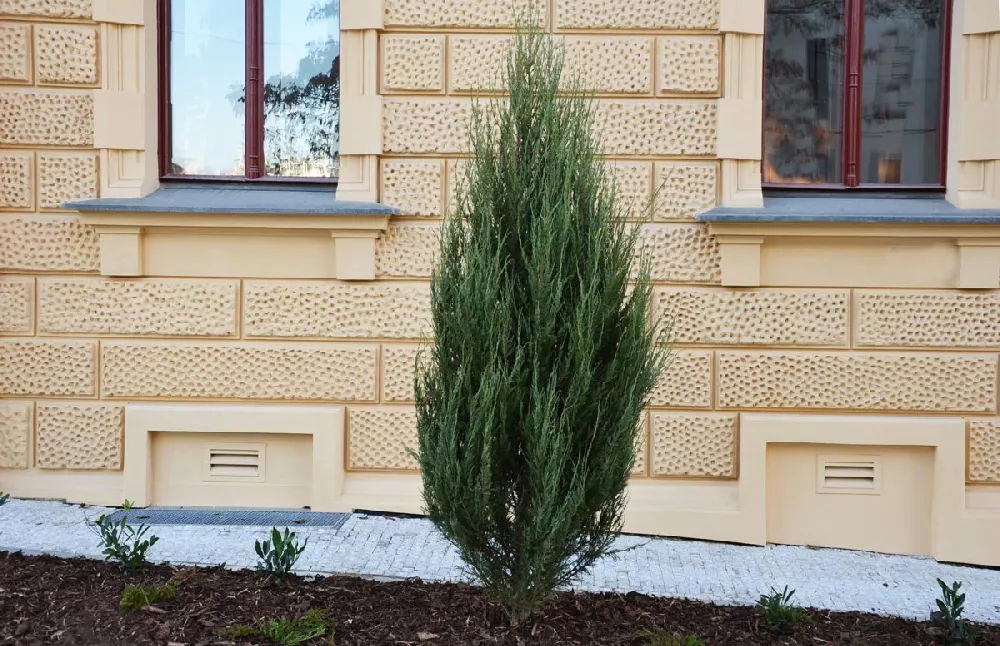- Home >
- Shrubs and Bushes >
- Juniper ‘Wichita Blue’ Tree
Juniper 'Wichita Blue' Tree for Sale - Buying & Growing Guide
- Ships in 1-2 days
- 1-Year Warranty Eligible
- Pots or accessories are not included unless specified in the product options.
Shipping Details:
Once your order is shipped, you’ll receive an email with a tracking number and estimated delivery date. Most orders ship immediately, but some items are seasonal and may only ship in spring or fall. These products are noted on the website.
The juniper 'Wichita Blue,' Juniperus scopulorum 'Wichita Blue,' is a small tree or large shrub that can fill several vital purposes in the garden or landscape. It is an excellent choice for a pruned hedge, but it also excels as a stand-alone specimen, where its handsome silver-blue foliage and tidy pyramidal shape can be appreciated. This long-lived evergreen offers four-season interest in the garden, and it is especially attractive to songbirds that feast on the blue berries in late summer. The juniper 'Wichita Blue' grows happily throughout much of the continental U.S., and is an easy-care plant that needs little pampering or extra fussing. Here are a few more reasons to consider a juniper 'Wichita Blue' for your own garden:
- Deer and large herbivores avoid it, though it is attractive to birds.
- It is cold-hardy down to -40 degrees Fahrenheit.
- It is tolerant of both road salt and urban pollution.
Plant Care
Sunlight

The Juniper 'Wichita Blue' thrives when it receives full sun — six or more hours of direct light a day.
Watering
This tree is drought-resistant once established. Water young trees once a week to develop a good root system.
Fertilizing

Fertilize in early spring with a balanced, slow-release fertilizer, such as a 10-10-10 formula.
Planting and Care
Planting instructions
Site your juniper in well-draining soil, in a spot where it will receive at least six hours of sun a day. Unpot the plant and tease out any encircling roots, which can girdle the tree and slowly kill it. Dig a hole that’s as deep as the root ball and twice as wide. Place the tree in the hole, spreading out the roots. Fill in around it with topsoil, tamping down as you go to eliminate air pockets. Water thoroughly. Apply a 2- to 3-inch layer of an organic mulch, such as bark chips, to conserve moisture and hinder weed growth.
Watering and nutrients
For its first year after planting, water your juniper weekly, giving it about an inch of water each time, unless it receives that amount from rain. Once the tree is established, it will only need supplemental watering during times of extreme heat or drought. Fertilize your juniper in early spring with a product designed for landscape trees and shrubs, preferably a balanced formula such as 10-10-10.
Pollination
As conifers, junipers don’t have flowers. Instead, they produce seeds in bracts that turn into cones. The wind is the pollinating agent for these shrubs, which then produce seed-carrying blue berries that are an attractive food source for birds.
Pruning
The juniper ‘Wichita Blue’ will form an attractive pyramidal shape on its own with little pruning. You may occasionally need to remove a dead, diseased, or broken branch, which you can do at any time. If you are using these shrubs to form a more formal hedge, however, you can prune rigorously to achieve the shape desired.
Pests and diseases
Junipers are hardy shrubs, and a healthy plant can resist insect infestations and diseases quite well. Common pests that may appear on your juniper ‘Wichita Blue’ include spider mites, aphids, and scale insects. One way to handle them is to release beneficial insects such as ladybugs, which prey on aphids. Junipers are susceptible to several fungal diseases including cercospora twig blight and phomopsis tip blight. Both cause needle browning, and both can be treated by applying a copper fungicide.
Achieving maximum results
Properly siting your juniper ‘Wichita Blue’ is an important factor in determining its success. If your juniper is going to be a stand-alone specimen planting, make sure to site it where there is good air circulation around it, since damp, humid conditions can encourage fungal diseases. A mature juniper can be 6 to 8 feet wide, so space your plants at least that far apart. If you wish to plant your shrubs close together so that they can be pruned into a formal hedge, be sure that there is good circulation and open space around the hedge.
FAQs
Where can I grow a juniper 'Wichita Blue?
How fast does the juniper 'Wichita Blue' grow?
These junipers are fairly fast growers and may put on nearly a foot of growth a year until they reach their mature height of 15 to 25 feet. The rate of growth will be impacted by weather conditions and the plant's care. Fertilizing regularly may cause an increased rate of growth.
How is the juniper 'Wichita Blue' best used in the landscape?
As we noted above, this juniper is an excellent specimen tree, with a handsome pyramidal shape and stunning blue-silver foliage. It also can be pruned into a formal hedge, windbreak, or privacy screen. Its relatively small size, which can be pruned to control height, makes it a good choice for smaller urban lots or tight spaces. A robust hedge will provide good erosion control for a hilly spot, and the shrub is also a fine choice for a wildlife garden, as it provides habitat and food for birds and small mammals.
Compare Similar Products
You can't add more Product Name - Product size to the cart.
OK








